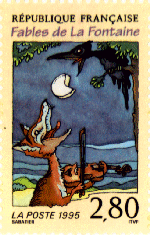


One of the things that I most enjoy about traveling is being placed outside of the narratives that I know. Although much of Paris feels familiar and negotiable, one is confronted daily with stories and cultural traditions that don't resonate. I think, for example, of David Sedaris' hilarious recounting of how America's Easter traditions differ from France's--"The teacher sadly shook her had, as if this explained everything that was wrong with my country. "No, no," she said. "Here in France the chocolate is brought by a big bell that flies in from Rome." I called for a time-out. "But how do the bell know where you live?" "Well," she said, "how does a rabbit know?" All this leads to a statue that I found in a playground outside of the Marmottan Museum. It seems to be retelling a fable, something about a crow with a coin in its mouth, and a fox. The statue had no explanation, and the man in the statue, who I assume is the author, clearly isn't Aesop. Does anyone know the story or the author?
---update
Thanks to Yakbeard the Pirate, the fable came from La Fontaine, probably retelling an Aesop fable, called Le Corbeau et le Renard. The title is Le Corbeau et le Renard
 Maître Corbeau, sur un arbre perché,
Maître Corbeau, sur un arbre perché,Tenait en son bec un fromage.
Maître Renard, par l'odeur alléché,
Lui tint à peu près ce langage :
"Hé ! bonjour, Monsieur du Corbeau.
Que vous êtes joli ! que vous me semblez beau !
Sans mentir, si votre ramage
Se rapporte à votre plumage,
Vous êtes le Phénix des hôtes de ces bois."
A ces mots le Corbeau ne se sent pas de joie ;
Et pour montrer sa belle voix,
Il ouvre un large bec, laisse tomber sa proie.
Le Renard s'en saisit, et dit : "Mon bon Monsieur,
Apprenez que tout flatteur
Vit aux dépens de celui qui l'écoute :
Cette leçon vaut bien un fromage, sans doute. "
Le Corbeau, honteux et confus,
Jura, mais un peu tard, qu'on ne l'y prendrait plus.
The Crow and the Fox

Master Crow perched on a tree,Was holding a cheese in his beak.
Master Fox attracted by the smell
Said something like this:
"Well, Hello Mister Crow!
How beautiful you are! how nice you seem to me!
Really, if your voice
Is like your plumage,
You are the phoenix of all the inhabitants of these woods."
At these words, the Crow is overjoyed.
And in order to show off his beautiful voice,
He opens his beak wide, lets his prey fall
The Fox grabs it, and says: "My good man,
Learn that every flatterer
Lives at the expense of the one who listens to him.
This lesson, without doubt, is well worth a cheese."
The Crow, ashamed and embarrassed,
Swore, but a little late, that he would not be taken again. :









